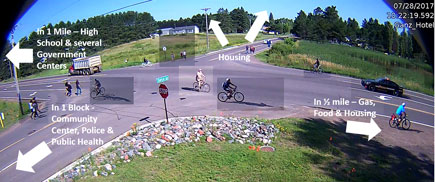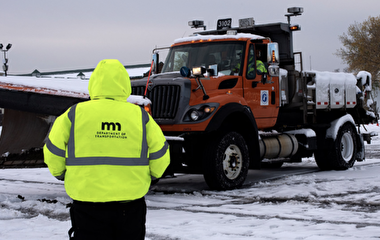The U of M’s work promoting transportation safety on tribal lands was showcased at the USDOT’s University Transportation Centers (UTC) Spotlight conference on May 14 in Washington, DC. The research poster was among 23 selected to exhibit at this one-day conference highlighting UTC program-supported transportation research activities.
The tribal safety research was conducted by Professor Greg Lindsey and Associate Professor Kathy Quick, both CTS Research Scholars with the Humphrey School of Public Affairs, and Guillermo Narváez with Proxemic Insights.
During the afternoon poster session held in the U.S. House, Quick and CTS director Laurie McGinnis shared information about the research with Congressional staff and other guests.
This research aimed to better understand and identify potential solutions for reducing the disparately high motor vehicle crash fatality rate for American Indians. In one project, Quick and Narváez collaborated with four tribal governments in Minnesota on case studies and conducted a national survey of tribes to identify key transportation safety risks in reservations. They found that pedestrian safety is a critical, under-recognized issue on many reservations, that improving road engineering and maintenance is tribes’ top road safety priority nationwide, and that tribes and other jurisdictions need to improve their coordination to enhance safety.
In other work, Lindsey assessed pedestrian safety at 10 locations on 4 reservations in Minnesota, monitoring pedestrian traffic and developing recommendations for countermeasures. Data from this project have been used by Mille Lacs tribal representatives to secure state funding for a new crosswalk and pedestrian-activated signal.
Another of Quick’s projects addressed tribes’ request to explore emergency medical service (EMS) response to motor vehicle crashes in reservations. Researchers conducted a national survey and analyzed factors including dispatch, remoteness of crash sites for ambulance and trauma care centers, training and equipment of first responders, and inter-jurisdictional coordination. Findings revealed that dispatch issues are critical, particularly cell phone coverage and pinpointing crash locations, since effective EMS response hinges on successfully placing a call for help.
The conference was co-hosted by the USDOT’s Council of University Transportation Centers and the Research, Education, and Training Reauthorization Coalition.



